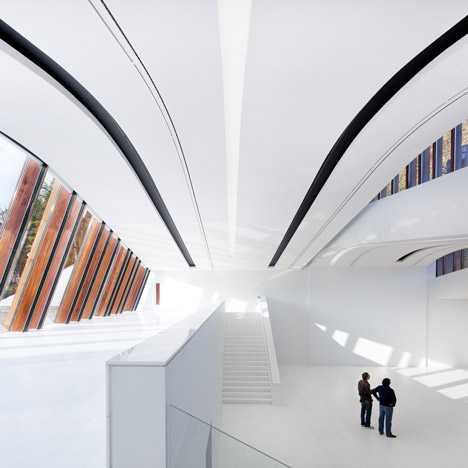Dutch architect Erick van Egeraat has completed an underground museum extension with a park on top in Assen, the Netherlands.
The new gallery wing at the Drents Museum is burrowed into the ground around a former coach-house, which is retained as a new ground-floor entrance.
Just past the foyer is a single large exhibition hall, with a ceiling of curved stripes that ascend above the ground surface to create high-level windows.
These folding waves create gentle slopes on the ground above, where pathways lead across a planted garden to the city beyond.
Erick van Egeraat has designed a number of projects in Europe, including a stadium in Moscow, a city hall in Budapest and an incinerator in Roskilde - see more projects here.
Photography is by J Collingridge.
Here's some more information from the architects:
Erick van Egeraat completes new Museum in Assen [NL]
On the 16th of November Erick van Egeraat’s new Drents Museum in Assen, the Netherlands, will be officially opened by Her Majesty Queen Beatrix of the Netherlands.
The festive re-inauguration of the Museum marks the official end of 18 months of construction within budget and timeframes.
Erick van Egeraat’s design was unanimously voted the winner at the design competition by the Jury and the client, the province of Drenthe.
His vision to use the extension of the Museum as an organizing instrument for the Museum as a whole was the decisive factor.
The most important aspect of Erick van Egeraat’s design is the consistent integration of the museum with the cities fabric.
A balanced play of building, landscape and water, creates a new identity for the extended museum.
The design reinforces both the scenic character and the cultural-historic face of Assen’s city centre.
The staggered, organic roof of the new wing connects existing gardens and parks in the city. Erick van Egeraat is thus creating a publicly accessible park.
Openings in the roof allow light to penetrate into the exhibition spaces below. The new wing links the new entrance with existing parts of the museum and the city landscape.
The existing coach-house will serve as the museum’s new main entrance.
Lifted 1 meter above the ground, the existing structure rests on a glass plinth, revealing the building’s new function in an elegant manner.
The historic façade is left untouched, therefore preserving the buildings civic appearance.
During the day, the glass plinth allows light to enter the building. At night, interior lighting transforms the coach-house into a beacon for the city and its inhabitants.

